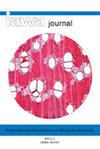Testing Carlquistian hypotheses on the functional significance of vessel element length
IF 3.5
3区 农林科学
Q2 FORESTRY
引用次数: 0
Abstract
While total vessel length is widely recognized as being of fundamental functional significance, opinion is more divided regarding the potential functional importance of vessel element length, a variable that Sherwin Carlquist regarded as functionally significant. We show that vessel element length can, as Carlquist predicted, affect vessel resistance to deformation. Perforation plates are locally thickened annuli, so tubes with annuli resist deformation better than those without, and tubes with closely-spaced annuli resist deformation better than those with distantly spaced ones. However, there is a tradeoff between deformation resistance and conductance. With a comparative analysis across more than 1000 species of angiosperms, we show that both vessel element length and the areas of individual inter-conduit pits scale positively with vessel diameter. Such covariation is expected if plants are to maintain conductance as they grow taller. Congruent with Carlquist’s thinking, we found that species with vessel elements that are exceptionally short tend to grow in drylands, whereas those with vessel elements that are exceptionally long tend to grow in moist climates. Finally, we show evidence suggesting that selection on vessel element length is an important determinant of imperforate tracheary element length. Conversely, the evidence for selection on imperforate tracheary element length affecting vessel element length appears to be weaker. These results seem sufficient to establish that, whatever the functional importance of total vessel length, vessel element length is a variable of functional significance in its own right, congruent with Sherwin Carlquist’s long-held views.检验卡尔奎斯关于血管元件长度功能意义的假设
虽然血管总长度被广泛认为具有基本的功能重要性,但关于血管元件长度的潜在功能重要性,意见分歧更大,Sherwin Carlquist认为这是一个具有功能重要性的变量。我们表明,正如卡尔奎斯特预测的那样,容器单元长度可以影响容器的变形阻力。穿孔板是局部加厚的环空,因此有环空的管子比没有环空的管子更能抵抗变形,环空间隔较近的管子比环空间隔较远的管子更能抵抗变形。然而,在变形阻力和电导之间存在权衡。通过对1000多种被子植物的比较分析,我们发现导管元件长度和单个导管间凹的面积都与导管直径成正比。如果植物在长高时要保持电导率,这种共变是预期的。与卡尔奎斯特的想法一致,我们发现具有特别短的导管元素的物种倾向于在旱地生长,而那些具有特别长的导管元素的物种倾向于在潮湿的气候中生长。最后,我们证明了血管元件长度的选择是不穿孔气管元件长度的重要决定因素。相反,选择不穿孔气管元件长度影响血管元件长度的证据似乎较弱。这些结果似乎足以证明,无论血管总长度的功能重要性如何,血管元素长度本身就是一个具有功能重要性的变量,这与Sherwin Carlquist长期持有的观点是一致的。
本文章由计算机程序翻译,如有差异,请以英文原文为准。
求助全文
约1分钟内获得全文
求助全文
来源期刊

IAWA Journal
农林科学-林学
CiteScore
3.40
自引率
15.80%
发文量
26
审稿时长
>36 weeks
期刊介绍:
The IAWA Journal is the only international periodical fully devoted to structure, function, identification and utilisation of wood and bark in trees, shrubs, lianas, palms, bamboo and herbs. Many papers are of a multidisciplinary nature, linking
 求助内容:
求助内容: 应助结果提醒方式:
应助结果提醒方式:


